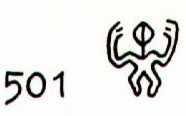|
A systematic analysis of what words Metoro used at glyphs with uplifted inwards oriented hands results in my idea that the concept is locality, e.g. noho = to sit, to stay, to live somewhere. Maybe there is a kind of logic, with one hand inwards bent meaning kai (= to eat, drink, talk etc), and two hands inwards bent - one from each direction - a place for kai, i.e. kainga. Then this image could be used for locality as such (-nga). This idea of mine fits in nicely with what Barthel writes about this type of glyph:
"Für Tu, der erstgeborenen Sohn des Gottes Tangaroa, wird als Herrschaftsregion 'Apai' oder 'Hapai' genannt, einer der fünf Bereiche des Jenseits.¹ ¹) Hiroa 1938, 421, 422, 424, 504. Ausführlich 470: 'Hapai was a good Po located in the sky... Tu and his descendants dwelt there... Hapai was a place of feasts and enjoyment. The entrance was through the mouth of Ruanuku... Ataatakirei, the home of Tu, was located in Hapai. Tagaroa visited his son Tu in Hapai after he left his wife Haumea... - Zur lokalisierung im Himmel vgl. das Auftreten von 'rangi' in Tafeltexten für den einäugigen Gott. - Zu 'ataatakirei' vgl. 'Apai'-Gesang (tangaroa te mare kura hapai). Tatsächlich scheint nun die besondere Armhaltung der Zeichens 501 gerade den Wert 'hãpai' zu besitzen und so eine ergänzende Ortsangabe für den Gott Tu darzustellen." (Barthel) |
